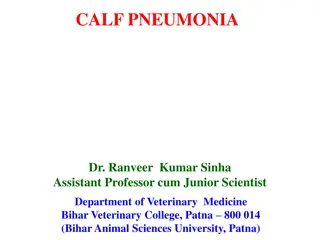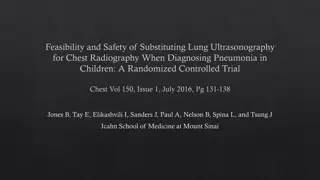DERMATOLOGY AND RHEUMATOLOGY
Staphylococcal Scalded Skin Syndrome (SSSS) is a serious condition characterized by red blistering skin resembling burns. It is caused by toxins from Staphylococcus aureus, leading to exfoliation of the skin. Common in infants, the elderly, and immunocompromised individuals, SSSS requires prompt dia
0 views • 89 slides
The Dust Bowl: Impact of the 1930s Drought
The Dust Bowl of the 1930s was a devastating period marked by severe drought, high winds, and dust storms in the Great Plains. It affected states like Texas, Oklahoma, Kansas, and more, leading to ruined crops, livestock losses, dust pneumonia deaths, and economic hardships. The lack of soil conserv
3 views • 14 slides
Evaluation and Treatment for Pneumonia in Patient with Penicillin Allergy
A 53-year-old woman, Katarina, presents with sudden illness of cough, high fever, and fatigue. With signs of pneumonia, but allergic to penicillin, the decision involves choosing appropriate treatment options such as PcV and considering past allergic reactions and infection history. Evaluating poten
3 views • 20 slides
Understanding Mechanical Ventilator Sensors and Actuators
Explore the essential components of mechanical ventilators, including sensors like pressure and flow sensors, actuators, and oxygen sensors. Learn about the functions and characteristics of these sensors and how they contribute to the operation of mechanical ventilators designed to assist patients w
6 views • 20 slides
Nursing Care for Ventilator-Associated Pneumonia (VAP)
Ventilator-Associated Pneumonia (VAP) is defined as lung parenchyma inflammation occurring 48 hours or more after endotracheal intubation and mechanical ventilation initiation. It is a common nosocomial infection in ICU patients, with significant morbidity and mortality rates. Etiology of VAP involv
2 views • 24 slides
Exploring Human Biochemistry: Anatomy, Systems, and Diseases
Delve into the intricate world of human biochemistry through a comprehensive exploration of the anatomy, systems, and diseases affecting the body. From the respiratory and circulatory systems to discussions on common ailments like colds, influenza, and pneumonia, this content provides an insightful
4 views • 42 slides
Understanding Pneumonia: Causes, Classification, and Risk Factors
Pneumonia is an infection of the lower respiratory tract that can be classified anatomically and etiologically. The common causes include bacterial, viral, and fungal pathogens, as well as aspiration pneumonia. Factors such as immune deficiency, overcrowding, and poor hygiene can increase the risk o
10 views • 37 slides
Overview of Mechanical Ventilation in Critical Care
Discussing the indication, modes, variables, and controls of mechanical ventilation as well as the differences between volume and pressure control. Exploring assist control, synchronized intermittent mandatory ventilation, and other key aspects of ventilator management by Dr. Zia Arshad.
0 views • 22 slides
RECOVERY Trial: Corticosteroids for Community-Acquired Pneumonia (CAP) - Overview and Eligibility Criteria
Community-Acquired Pneumonia (CAP) is a common reason for hospitalization globally, with estimated annual fatalities of approximately 2.5 million. The RECOVERY Trial is investigating the use of corticosteroids in patients with CAP suspected or confirmed to be of bacterial origin. Eligibility criteri
1 views • 13 slides
Anesthesia Machines Market Projected to Reach $7.71 Billion by 2030
Anesthesia Machines Market by Offering (Anesthesia Workstation, Delivery Systems, Portable, Monitor, Ventilator, Circuit, Mask, Vaporizer), Application (Orthopedic, Neurology, Cardiology, Urology), End User (Hospital, Clinic, ASC) - Global Forecast to 2030\n
0 views • 5 slides
Home Healthcare Market is Projected to Reach $514.5 Billion by 2030
Home Healthcare Market by Offering (Fertility, Pregnancy, Cholesterol Tests, Oximeter, CPAP, Nebulizer, Ventilator, Dialysis, Patient Support Equipment), Service (Rehabilitation, Telehealth, Nursing, Hospice), Application (Cardiovascular, Diabetes, Respiratory) - Global Forecast to 2030\n
0 views • 5 slides
Understanding Delirium: A Micro Learning Module for Clinicians
Delirium is a sudden change in an individual's memory, thinking, and behavior, which requires urgent medical attention. Often misdiagnosed, it can be mistaken for other conditions like depression or dementia. Knowing the signs and symptoms, such as fluctuating confusion, difficulty focusing, and cha
1 views • 9 slides
Diagnostic Specialty Antibodies Market is expected to grow at a CAGR of 4.6% fro
Diagnostic Specialty Antibodies Market by Type (Primary, Secondary), Clonality (Monoclonal, Polyclonal), Technique (WB, Rapid Test, IHC, IP), Conjugate, and Application (Dengue, Malaria, Hepatitis, HIV, E. coli , Tuberculosis, Pneumonia, Cancer)- For
0 views • 6 slides
Understanding Lymph Node Examination in Food Animals
The lymphatic system plays a crucial role in maintaining the body's health by supplying oxygen and nutrients to tissues and removing waste products. Lymph nodes are round masses of lymphoid tissue found along lymphatic vessels, containing lymphocytes within a capsule of connective tissue. Characteri
1 views • 9 slides
Understanding Thickened Liquids in Dysphagia Management
Thickened liquids are often recommended for residents with swallowing difficulties to prevent aspiration pneumonia. Recommendations are typically made by speech pathologists, with nursing sometimes adjusting based on availability of therapy. Aspiration pneumonia occurs when substances are inhaled in
2 views • 33 slides
What is Pneumonia What to Eat and Avoid in it
Pneumonia is a serious infection that requires careful management, especially in children. Ensuring properhydration and a balanced diet rich in proteins, vitamins, and probiotics can aid in recovery
0 views • 7 slides
The Role of Vitamin D in Enhancing Immunity Against COVID-19
Exploring the relationship between Vitamin D and COVID-19, this research article delves into how Vitamin D mechanisms can help fight viral infections by reducing pro-inflammatory cytokines and minimizing the risk of a cytokine storm. Studies suggest that Vitamin D may play a crucial role in reducing
0 views • 22 slides
Klebsiella Species: Characteristics and Pathogenicity
Klebsiella species, such as K. pneumoniae and K. oxytoca, are gram-negative bacilli commonly found in the microbiota of the intestines, nasopharynx, and feces. They exhibit distinct characteristics like pink mucoid colonies on MacConkey's agar and are known to cause both community-acquired and hospi
0 views • 24 slides
Brain Oxygen Optimization in Severe TBI - Protocol Summary
In the severe traumatic brain injury (TBI) protocol, intracranial monitors measuring ICP and PbtO2 are placed within 12 hours of injury. Procedures include FiO2 challenges to check PbtO2 reliability and assess cerebral physiology. Challenges involving FiO2, MAP, and CO2 help guide ventilator setting
2 views • 27 slides
Mycoplasma: Structure, Reproduction, and Characteristics
Detailed exploration of Mycoplasma covering its structure, reproduction, and general characteristics. Discusses the ultrastructure, species like Mycoplasma pneumonia and Mycoplasma hominis, and their unique traits such as lack of cell wall, pleomorphism, and reproduction methods. The article also to
0 views • 14 slides
Comprehensive Overview of Pneumonia: Causes, Epidemiology, and Management
Pneumonia is an inflammatory lung condition that can be caused by viruses, bacteria, or other microorganisms. It affects millions of people worldwide, with a significant impact on newborn infants. The presentation covers the definition, epidemiology, types, etiology, risk factors, and management of
0 views • 27 slides
Airway Clearance Techniques for Pediatric Patients with Special Healthcare Needs
Explore the strategies and technologies used to assist children with impaired airway clearance, including tracheostomy care, mechanical ventilator support, and supplemental airway clearance activities such as chest physiotherapy and oral care.
0 views • 28 slides
Home Healthcare Market: Insights into Cost-Effective Solutions
Home Healthcare Market by Offering (Fertility, Pregnancy, Cholesterol Tests, Oximeter, CPAP, Nebulizer, Ventilator, Dialysis, Patient Support Equipment), Service (Rehabilitation, Telehealth, Nursing, Hospice), Application (Cardiovascular, Diabetes, R
0 views • 3 slides
Overview of Physical Vapor Deposition (PVD) Techniques in Thin Film Deposition
Physical Vapor Deposition (PVD) includes various vacuum techniques for depositing thin films on substrates through physical means. This method involves a dry vacuum process to coat objects with different materials. PVD processes utilize methods like Mechanical, Evaporation, Sputtering, Ion plating,
0 views • 31 slides
Understanding Calf Pneumonia: Symptoms, Treatment, and Consequences
Calf pneumonia is a significant disease in calves aged one to five months. It is essential to diagnose, treat, and prevent this multifactorial disease for the cattle industry. With types, causes, symptoms, and consequences discussed in detail, the content also covers treatment options like antibioti
0 views • 13 slides
Ventilator Assisted Care Program at Children's Hospital New Orleans
This program at Children's Hospital New Orleans provides ventilator-assisted care for children, ensuring they receive necessary medical support. It covers medication administration, legal rights, historical background, guidelines for care, prohibited medications, and roles and responsibilities of li
0 views • 49 slides
Oral Health in Mechanically Ventilated Adults: Importance and Challenges
Mechanically ventilated patients are vulnerable to oral health complications, such as ventilator-associated pneumonia, due to lack of consistent oral care. This article discusses the impact of poor oral hygiene on systemic health, reasons for the lack of oral care regimen, and strategies to promote
0 views • 29 slides
Review of Care for Adults with Community-Acquired Pneumonia
This review focuses on the care provided to adults diagnosed with community-acquired pneumonia (CAP) in hospitals. Key findings include the importance of accurate diagnosis, clinical decision making, and antibiotic management. The study assessed the quality of care through various questionnaires and
0 views • 23 slides
Overview of Necrotizing Pneumonia in Children
Necrotizing pneumonia in children is characterized by necrosis of pulmonary tissue, leading to the formation of small cavities containing necrotic debris or fluid. Staphylococcus Aureus and Streptococcus Pneumoniae are common pathogens. Treatment involves a prolonged course of IV antibiotics tailore
0 views • 34 slides
Antibiotics in Action: Pneumonia Management with Ceftriaxone
Dr. Alyssa Castillo presents strategic antibiotic selection tools for common infections like pneumonia, UTI, and cellulitis, focusing on frequently utilized antibiotics like ceftriaxone. The case study explores treating a 55-year-old pneumonia patient with IV ceftriaxone and discusses additional ant
0 views • 55 slides
Clinical Management Guidelines for Critically Ill Adults with COVID-19
The guidelines focus on managing severe acute respiratory infections suspected to be COVID-19, covering oxygen supplementation starting recommendations, SpO2 targets, use of HFNC and NIPPV, risk of aerosol transmission, initial ventilator settings, troubleshooting, and the transition to invasive mec
0 views • 8 slides
Managing Noninvasive Ventilation Weaning Process
Discontinuing noninvasive ventilation in patients with acute respiratory failure involves a gradual process of assessing the condition, monitoring for distress signs, and adjusting ventilator assistance accordingly. Successful weaning depends on the reversibility of the underlying respiratory issue.
0 views • 28 slides
Enhancing Care for Long-Term Care Residents Through Early Detection and Intervention
This collection of resources highlights the importance of identifying acute changes in long-term care (LTC) residents, focusing on potentially preventable conditions such as chronic obstructive pulmonary disease, urinary tract infections, pneumonia, and heart failure. It underscores the risks associ
0 views • 25 slides
Ventilation in Critical Care: Basics and Calculations
Understanding mechanical ventilation is crucial in managing critically ill patients. This content covers concepts like I:E ratio, total cycle time calculation, inspiratory and expiratory times, and practical examples. Learn how to adjust ventilator settings based on patient parameters and conditions
0 views • 11 slides
Understanding Hospital-Acquired Pneumonia: Epidemiology, Etiology, Diagnosis & Treatment
Hospital-acquired pneumonia is a serious infection occurring at least 2 days after hospital admission, leading to complications and mortality. It can be classified into VAP and HCAP, with various predisposing factors and microbiological causes. Recognizing clinical features and prompt treatment are
0 views • 29 slides
Addressing Ethical Disputes in Pediatric Ventilation: The EMPALA Initiative
The EMPALA initiative aims to resolve ethical disputes between parents and medical teams regarding children on ventilator support. By providing empathetic patient advice and non-medical arbitration services, EMPALA seeks to prevent court proceedings and unnecessary resource wastage. Breathe.On UK is
0 views • 10 slides
Utility of Lung Ultrasonography in Pediatric Pneumonia Diagnosis
Pneumonia, a leading cause of pediatric mortality globally, presents diagnostic challenges as history and physical exams may not reliably differentiate viral lung infections from bacterial pneumonia. This study explores the feasibility and safety of substituting lung ultrasonography (LUS) for chest
0 views • 21 slides
COMBACTE-CARE: Combatting Bacterial Resistance in Europe - Study Overview
A Phase III study comparing the efficacy, safety, and tolerability of aztreonam avibactam (ATM-AVI) and meropenem colistin (MER-COL) for treating serious infections caused by Gram-negative bacteria, including MBL-producing pathogens. Approximately 300 patients with complicated intra-abdominal infect
0 views • 9 slides
Global Action Plan for Prevention of Pneumonia and Diarrhoea
The Integrated Global Action Plan for Prevention and Control of Pneumonia and Diarrhoea (GAPPD) aims to address the significant impact of these diseases on children under five globally. Released by WHO and UNICEF, the plan focuses on protecting children, preventing diseases, and treating illnesses t
0 views • 17 slides
Emergencies in hematology
A 59-year-old patient with chronic lymphocytic leukemia presented with pneumonia and disease progression. Refusing chemotherapy, he developed severe pneumonia and worsening symptoms. Laboratory tests revealed critical values for leukocytes, hemoglobin, and thrombocytes, along with abnormal biochemis
0 views • 27 slides







































